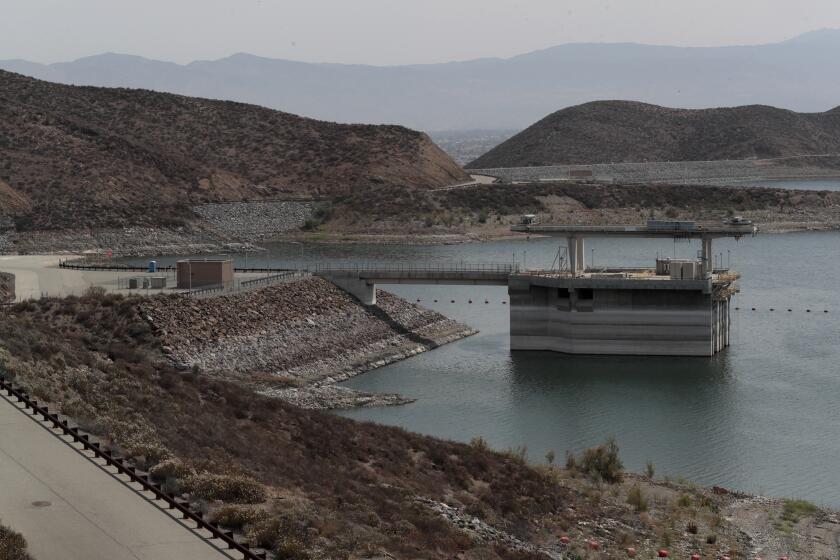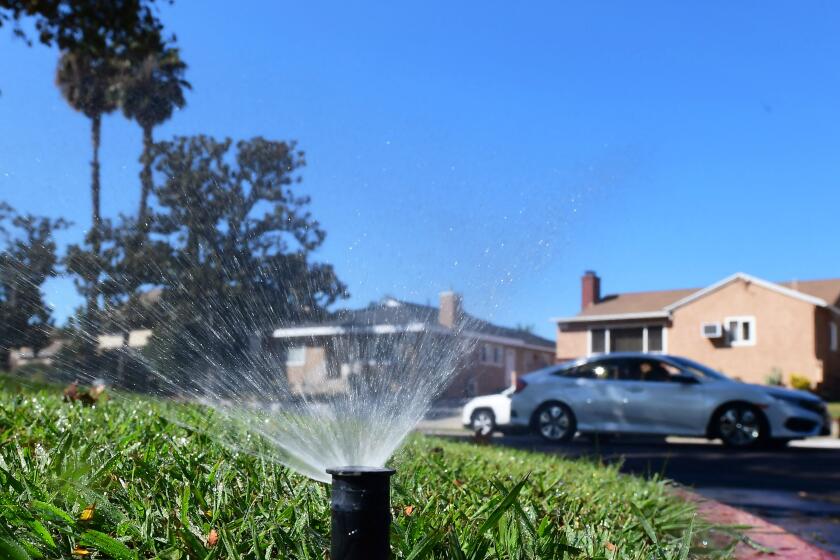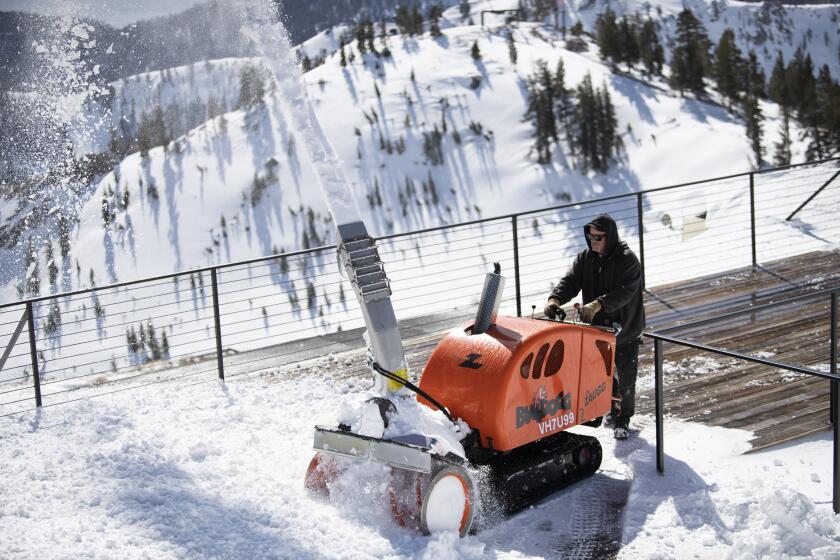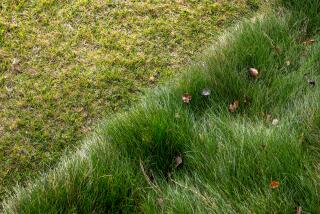Southern California ‘cannot afford green lawns’ as drought forces unprecedented water cuts

Large portions of Southern California are being told to water outdoors just one day a week. And a total watering ban could be imposed by fall.
Millions of Southern California residents are bracing for less water and many brown lawns as drought and climate change leave a large swath of the region with a growing water shortage.
In a remarkable indication of drought severity, officials with the Metropolitan Water District of Southern California have declared a first-of-its-kind action limiting outdoor water use to one day a week for nearly 6 million residents.
Much remains to be determined about how daily life will change as people adjust to a drier normal. But officials are warning the situation is dire and could lead to even more severe limits later in the year.
“We have not had the supply to meet the normal demands that we have, and now we need to prioritize between watering our lawns and having water for our children and our grandchildren and livelihood and health,” MWD General Manager Adel Hagekhalil said Wednesday. “With this historic drought getting worse, we cannot afford green lawns.”
For some Californians, the sight of brown lawns may harken back to to the previous drought, when then-Gov. Jerry Brown imposed mandatory water cuts across the state. But after the driest-ever start to the year in California history, conditions today are far more critical than they’ve ever been, officials said.
“We knew climate change would stress our water supply, and we’ve been preparing for it, but we did not know it would happen this fast,” said Gloria Gray, chairwoman of the MWD’s board of directors. “This means we are attempting to adapt to climate change in real time, and that is not easy. It is a challenge unlike anything Metropolitan has ever faced.”
For the first time ever, Southern California water officials will limit outdoor watering to just once a week in certain areas beginning June 1.
The new restrictions will take effect June 1 and apply to areas that depend on water from the State Water Project, including northwestern L.A. and Ventura counties, parts of the San Gabriel Valley and parts of the Inland Empire.
Officials said the step became inevitable after California experienced its driest ever January, February and March. That left snowpack shrunken and reservoirs drained, prompting state water officials in March to slash the project’s expected deliveries from an already low 15% to 5%.
Now, it falls to the MWD’s member agencies to determine how to implement the restrictions, officials said. Those suppliers who fail will be slapped with a penalty of up to $2,000 per acre-foot of additional use.
If vast improvements aren’t immediate and apparent, a full outdoor watering ban could happen as soon as September, Hagekhalil said.
Outdoor water usage will be restricted to just one day a week for about 6 million people in parts of Los Angeles, Ventura and San Bernardino counties.
“We’re behind on precipitation. But it’s the changing climate that we cannot rely on anymore,” he said. “This is real. This is serious. This is unprecedented.”
Last month, Gov. Gavin Newsom issued an order aimed at scaling up urban conservation and suggested a ban on watering decorative grasses at businesses and public properties, among other measures. The order followed reports that Californians were backsliding in their efforts to conserve water, and had in fact increased water use at the start of the year.

Newsom’s office said in a statement that the action by the MWD was a great example of local initative, and “we are hopeful these efforts will significantly contribute to the state’s overall water reduction goals as outdoor watering is one of the biggest single users of water.”
But for some residents, the move may be a harsh wake-up call to the realities of the worsening drought.
New Southern California drought rules limit outdoor watering to once a week in some areas. Here’s what you need to know.
In Windsor Square on Wednesday, many houses sat behind large privacy hedges, their front yards replete with stalks of lavender, flowering jasmine and bushy bitter willows.
Scott Rosenbaum, who was walking his two golden retrievers in the area, said his lawn is currently being watered about three times a week. He said he would prefer not to be restricted to watering once a week, “but if we have to conserve water, then of course we have to conserve.”
John Eisendrath, who lives a few blocks over, said he and his wife had already been looking into water conservation measures for a long time. They turned off the sprinklers in their yard for all of 2021 to save water, which resulted in the lawn dying. They replanted it at the start of 2022, but are fine if it ends up dying again because of the new restrictions.
“I think that it’s an incredibly small price to pay for allowing there to be enough water for what people really need it for,” he said.
The decision to restrict outdoor watering to one day a week for millions of Southern Californians could presage even stricter actions in September.
The Las Virgenes Municipal Water District, an MWD member agency that provides water to more than 75,000 residents in Agoura Hills, Calabasas, Hidden Hills and Westlake Village, has already made plans for enforcing the new rules, according to spokesman Mike McNutt.
The agency plans to divvy up watering days among even- and odd-numbered addresses, and then send patrols through the area to ensure that people are complying, McNutt said. They’re also going to keep an eye out for waste, such as water that’s flowing into gutters.
Residents who are not complying will be given door-tag warnings for their first offense, with penalties escalating from there, he said. After three offenses exceeding 150% of the water budget, the agency would be able to install flow-restriction devices.
“It’s not meant to be punitive. It’s meant to get people to understand that this is serious,” McNutt said.
The MWD’s largest member agency, the Los Angeles Department of Water and Power, has so far provided few details about how it plans to apply the latest changes.
DWP spokeswoman Ellen Cheng said the agency has had Phase 2 water restrictions in place since before the previous drought, and noted that customers have made major progress in conservation, averaging about 111 gallons per person per day.
But experts say that number may be too much. Hagekhlalil, of the MWD, said the target needs to be closer to 80 gallons per person per day.
“We’re asking them to reduce the water usage by 35%. This is the new reality. This the changing climate,” Hagekhalil said. “Right now, we must preserve the available water we have for the greater public benefit. This drought has left us without enough water. That is the tough reality we all face.”
Some water experts have been saying for months that California should shift to mandatory water restrictions, instead of voluntary calls for conservation.
“The outdoor water restrictions, I think, underscore the severity of the drought and they highlight the imperative to use water more efficiently,” said Heather Cooley, research director of the Pacific Institute, a water think tank in Oakland. “Outdoor water restrictions have been shown to be effective strategies for rapidly reducing water use. I do suspect that more communities will adopt these measures as conditions worsen.”
Cooley said that in this situation, it’s especially crucial to consider how low-water and drought-resistant plants can dramatically boost conservation.
“While this is a short-term drought response measure, this is also an opportunity to be taking out water-intensive lawn and putting in more climate-appropriate plants,” she said.
New Southern California drought rules limit outdoor watering to once a week in some areas. Here’s what you need to know.
Stephanie Pincetl, a professor at UCLA’s Institute of the Environment and Sustainability, agreed.
“Lawns do well with about 30 inches of rain a year. Do we get 30 inches of rain a year? I don’t think so,” Pincetl said. Los Angeles receives about half that amount in a typical year.
“So if you want to have water to drink, water to do all the stuff you do inside, bathe your children, do your laundry, using water on a lawn just seems foolish,” Pincetl said.
There are exceptions to the new rules, however, that are meant to protect the region’s trees, which provide valuable shade and help stave off dangerous heat health effects.
“The fact is, we don’t want to see our beautiful and ecologically important tree canopy suffer because of these restrictions,” said Deven Upadhyay, the MWD’s chief operating officer. “People should be able to continue to hand-water their trees. But we need to see a dramatic reduction in water use, specifically outdoor water use.”
Dan Drugan, manager of resources for the Calleguas Municipal Water District, an MWD member agency, shared similar sentiments.
“We’re going to have to sacrifice turf to preserve the urban canopy and the areas that have high recreational value for our community,” he said.
Although April’s rain and snow have been impressive, nearly all of the state remains under significant drought conditions, officials said.
Larchmont resident Guin Malley said her sprinklers are currently running every other night, but her lawn will definitely not survive the switch to once-a-week watering, especially during the hot summer months. However, it didn’t surprise her that the watering restrictions are back.
“I like having green lawns, but I think we’re entering a different time of life right now where unfortunately, we haven’t made the easy changes,” said Malley, 51, “and now we’re going to have to make the harder changes. And one of them is not being able to have pretty green lawns and pretty green yards.”
She and her boyfriend also have several plants they hand-water every day during the summer. Malley said she believes people in the neighborhood are likely to follow the restrictions, especially if they are enforced by fines.
And it won’t be hard to tell who’s flouting the rules.
“To me, anybody who’s following it is going to have a dead lawn, that’s how you’re going to be able to tell,” Malley said.














